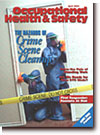
April 2003
Features
By Amy Shugart
IN today's workplace, safety managers make tough choices every day that affect lives and their companies' bottom lines. Hand, eye, hearing, and bodily protection are key to any successful safety program. Another critical, sometimes overlooked, element in preventing workplace injuries is foot protection.
By OH&S Staff
Editor's note: Patricia A. "Pat" Gleason is president of the Safety Equipment Institute, a private, nonprofit organization created in 1981 to administer non-governmental, third-party certification programs to test and certify safety equipment. SEI's certification programs are accredited by the American National Standards Institute. The institute (call 703-442-5732 or visit www.SEInet.org) has its headquarters in McLean, Va.
By Stephen V. Magyar, Jr., MBA, CSP
KNOWING who your employees are begins at the time when you hire them. Many do's and don'ts must be considered, but in the final analysis, we must take our employees as we find them--with all their physical limitations, disabilities, job skills, etc.--and assign them.
By Joy M. Ebben, Ph.D, CPE, CHFEP
STATIONARY standing is a posture often taken by workers when performing their job duties. There are a number of applications where standing is the recommend working posture, as opposed to sitting. Standing work, compared to sitting when working, is recommended when the task cannot be performed with the employees keeping their arms comfortably at their sides.
By Bill Current
WHILE America as a nation continues to struggle with the problem of drug abuse, U.S. employers continue to make progress in their war on drugs. A key weapon in that war continues to be drug testing. The screening of job applicants and employees for the illegal use of drugs has become as much of the fabric of American work life as paychecks and paid sick leave.
By Barbara C. Burton, M.Ed.
PERHAPS before discussing first aid kits, we should consider the question, "What is first aid?" Does it refer to treatment delivered prior to more definitive medical care available at a clinic or hospital? Is it simply the placing an adhesive bandage over a small cut?
By Kimberly Dennis
IN many occupations--even outside of hospitals and other health care environments--workers run the risk of being exposed to potentially hazardous bloodborne pathogens and bodily fluids. In fact, it is estimated that approximately 5.6 million workers in the United States are at risk of exposure to bloodborne pathogens.
By Jacque S. Greiff
OSHA has given us standards for industry. Confined spaces, trenches, scaffolding, forklifts, high steel--you name it and there's a standard written for it. There are good reasons for these standards: They do, in fact, save lives.
By Dale M. Petroff
IN 1941, the people of the United States believed they were safe behind a two-ocean barrier. They were proved wrong by the attack on Pearl Harbor. That attack was conducted by the armed forces of a hostile nation. In 2001, the people of the United States believed that, as the world's only superpower, they were safe from attack. Again, they were wrong.
By Mark A. Ceaser
PRIOR to the early 1980s and the introduction of AIDS into our society, infection control practices were designed almost exclusively to protect the patient from developing a nosocomial infection--an infection acquired after admission to the hospital.
By Roger Brooks, Jr.
DRUGS in the workplace: The mere thought is enough to send bosses searching for the nearest brown paper bag. Drug users mean violence, theft, and accidents. Illicit substances, dangerous as they may be, are only one part of an employer's worry.
Departments
By Jerry Laws
WE'RE broke. Putting it more precisely, our retirement is busted, tapped out, barely breathing on government life support.
By Errol Wirasinghe, Ph.D.
DECISION-making embraces every facet of your life. Whether you are in sales, education, health care, energy, finance, marketing, pharmaceuticals, or politics, you will be required to make crucial decisions.
By Valerie Weadock
AS if it weren't hard enough keeping business flowing smoothly and clients and employees safe and happy, you must also keep up with the latest technology.